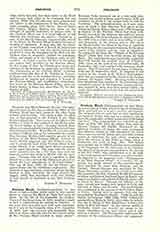

Precious Blood, CONGREGATION OF THE MOST, an association of secular priests living in community, whose principal aim is to give missions and retreats. The members take no vows but are held together by the bond of charity only and by a promise “not to leave the community without permission of the lawful superior”. The congregation was founded at the desire of Pius VII after his return from exile by Blessed Gaspare del Bufalo. Distressed at the spiritual condition of Rome, the pope determined that missions should be held throughout the Papal States and selected del Bufalo and a few other zealous priests to undertake the task (1814), assigning to them the convent of San Felice at Giano, where a foundation was made August 15, 1815. New houses were opened, and in 1820 six missions were established in the Campagna for the conversion of the banditti. The growth of the society was checked at the election of Leo XII (1823), who, misinformed as to the work of the congregation and its founder, was unfavorable. He objected to the proposed name, “Congregation of the Most Precious Blood”, as a novelty; but the society was finally cleared of all accusations and P. Betti justified the name from Scripture and the Fathers. Blessed Gaspare was succeeded by Don Biagio Valentini, a member of the society since 1817. His successor, the Ven. Giovanni Merlini (the process of whose beatification has been begun in Rome), was a native of Spoleto and a friend of Pius IX, whose exile at Gaeta he shared. Through the influence of the pope, several new houses were opened in Italy, and one each in Alsace and Bavaria. The motherhouse was established in the convent of the Crociferi, Maria in Trivio. Merlini died January 13, 1873, and was succeeded by Don Enrico Rizzoli. Under his rule the Italian Government (1860, 1866, 1870) confiscated, among others, Maria in Trivio, since when the fathers who are in charge of this church have to rent a few rooms in their own house. In the convent garden a Methodist church was erected, but owing to the scanty attendance it was soon closed and is now used as a theatre. The Government confiscated the revenues of the seminary at Albano and suppressed altogether twenty-five houses. The Kulturkampf closed the houses in Alsace and Bavaria. Rizzoli was succeeded by Msgr. Caporali, in 1890 consecrated Archbishop of Otranto; Msgr. Salvatore Palmieri, to whom the Government refused the exequatur when he was named Archbishop of Rossano, but later acquiesced in his preconization as Archbishop of Brindisi (1893); Aloysius Biaschelli; the present general is Very Rev. Hyacinthe Petroni.
The congregation was introduced into America (1844) at the request of Bishop Purcell of Cincinnati, by Rev. Francis de Sales Brunner (q.v.). It conducts a college (Collegeville, Ind.) and parishes in Ohio (Dioceses of Cincinnati, Cleveland, Toledo), Indiana (Diocese of Fort Wayne), Missouri (Diocese of St. Joseph and Kansas City), Illinois (Archdiocese of Chicago), Nebraska (Diocese of Lincoln). The chief work of the order is the giving of missions and assisting the secular parish clergy on occasions such as tridua, Forty Hours devotions, retreats etc. The novitiate is at Burkettsville, Ohio.
In America candidates pass through a year of probation, after which they are admitted either as brothers, and then take the promise of fidelity, or as students, to follow a six years’ course in classical studies. Such of the students as receive the degree A.B. enter the seminary, and after the first year of philosophy give the promise of fidelity. After five years more of study, they are ordained, and a year later become eligible to full membership. If the ballot is favorable, they are admitted and invested with the missionary’s insignia (a large ebony crucifix with brass figure and brass chain, worn over the heart). In Europe the method of adopting members is somewhat different, since there none are admitted before they are at least students of philosophy; often priests join the congregation.
The present statistics for the congregation are: Italy, 3 provinces, 15 houses, the principal ones being at Rome (Santa Maria in Trivio), Albano, and San Paolo; Spain, 1 province, 2 houses; North America, 1 province with a seminary at Carthagena, Ohio, seat of the provincial; a college at Collegeville, Ind., with 300 students; novitiate at Burkettsville, Ohio; parishes and missions: Ohio, 19; Indiana, 4; Missouri, 6; Nebraska, 2. The house at Shellenberg (Liechtenstein) belongs to the American province. There are in the American province 110 priests, 20 seminarians, 75 collegians, 70 lay-brothers, 35 novices, 17 convents, and 44 missions and stations.
PRECIOUS BLOOD, KNIGHTS OF THE.—At Mantua in 1608 a knight-order of the Precious Blood, which received the approval of Paul V, was founded by Vincente del Gonzaga, Duke of Mantua. Its aim was to protect the sacred relic of the Precious Blood. The members wore on a golden ribbon a remonstrance, representing two angels holding up a vase containing three drops of blood. The Dukes of Mantua were grandmasters, until Emperor Joseph I declared the dukedom abolished; the order was then dissolved. The sacred relic is said to have disappeared since 1848.
ULRICH F. MUELLER

